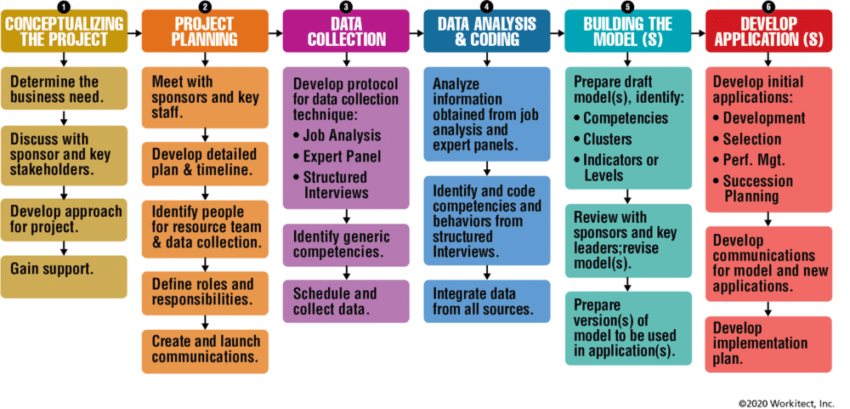The 6-step process infographic is used by Workitect’s consultants to build job competency models for organizations, and is taught in the Building Competency Models workshop.
This blog post will describe Step 1: Conceptualizing the Project.
STEP 1 – CONCEPTUALIZING THE PROJECT
The key components of conceptualizing the project are:
- Thinking through the need
- Clarifying the need through discussions with the sponsor and other key stakeholders
- Developing an approach
- Gaining the sponsor’s support for the approach
A. Thinking through the Need
In thinking through the need, it is helpful to consider the following questions:
- What is the business need for the competency model(s)?
- What HR applications will be built using the competency model(s) to address the business need?
- What is the organizational context?
- What business or organizational changes have occurred?
- What other competency models exist or are planned?
- Has the organization developed a mission or values statement?
- What is the organization’s strategic plan or direction?
- What aspects of the organization’s culture should be taken into account when considering this work?
- What HR applications and programs are already in place for selection, professional development, assessment, and performance management?
- Who will sponsor this work? What are the sponsor’s needs and concerns?
- What other key stakeholders will be affected by the competency model and its applications? What are their needs and concerns?
B. Clarifying the Need
You probably will not have answers to all of the above questions and it is likely that the sponsor and other key stakeholders will have perspectives and concerns that you have not thought of. By talking with your sponsor and with some other key stakeholders, you can clarify what is needed. In addition, sounding out key stakeholders and demonstrating interest in their needs, you will begin to build support for the project.
C. Developing an Approach
There are three main approaches to competency model building. Developing an approach involves selecting one of the approaches and adapting it to the needs of the organization. The three approaches are:
- Single Job Competency Model
- One-Size-Fits-All Approach
- Multiple Job Approach
A project usually focuses on one of these approaches, although it is possible to use a combination of these approaches within one organization.
– Single Job Competency Model
This approach focuses on a single, narrowly defined job that is important to the organization’s success and has at least 10 job-holders. The jobs covered by the competency model should have similar responsibilities and performance measures. Any requirements for technical skill or knowledge should be similar across the set of jobs. Examples of jobs for which a single job competency model is appropriate include sales representative, customer service representative, project manager, and plant manager.
The single job approach uses extensive and rigorous data collection, to ensure that the competency model contains highly specific behavioral descriptions of what one needs to do and how, in order to achieve superior results. This approach often includes a detailed breakdown of the main responsibilities and tasks and shows how they are linked to the competencies. Compared to the other two approaches, the single job approach is more time consuming and expensive to implement.
– One-Size-Fits-All Approach
In the One-Size-Fits-All Approach a competency model is developed for a broadly defined set of jobs that may have very different responsibilities and knowledge requirements. Most often, the competency model is developed for one level of jobs, such as managers, associates, or senior leaders.
The competency model often includes competencies selected for alignment with the company’s values and strategic direction. Thus competencies may have names like “Fostering Teamwork” or “Results Orientation.” The competencies are often described in general terms that are not job specific, since the competency model covers a broad range of jobs which may have significantly different responsibilities.
– Multiple Jobs Approach
In the Multiple Jobs Approach competency models are developed simultaneously for a set of jobs (e.g., all professional jobs in marketing; all R&D jobs, or all the job in a small organization). This approach is appropriate whenever competency models are needed for several jobs within an organization. The approach is especially useful when it is important to specify technical skill/knowledge requirements.
This approach is also appropriate when HR staff plan to apply the competency models for career planning and succession planning, which involve matching employee assessments to the requirements of multiple jobs. Because the administrative management of multiple competency models can be complex, many good technological solutions have been developed for this purpose. Some involve purchasing or leasing software, while others involve purchasing a license to use web-based applications that reside on third party servers. Technology facilitates competency assessment, development planning, and internal selection.
D. Gaining the Sponsor’s Support for the Approach
Before you can begin a competency-modeling project, you need to have your sponsor’s support, first for the general conceptual approach and later for a project plan that specifies the time, money and other resources that will be required. Before developing a detailed plan, it is useful to ensure that the sponsor supports your general conceptual approach. Therefore, you need to share your approach with the sponsor and check to see if you have your sponsor’s support. You can do this in an in-person or telephone meeting.
Next Blog Post: Step 2 – Project Planning

The Only Totally Integrated Talent Management System
 For additional information, call 800-870-9490, email edward.cripe@workitect.com
For additional information, call 800-870-9490, email edward.cripe@workitect.com
or use the contact form at Workitect.
©2023, Workitect, Inc.




Leave A Comment